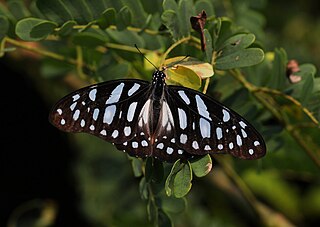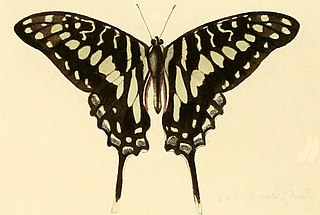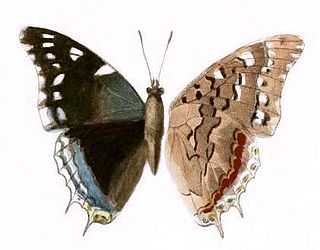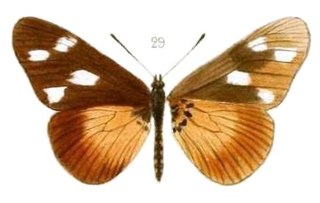
Acraea acrita, the fiery acraea, is a butterfly of the family Nymphalidae. It is found in large parts of Africa.

Bicyclus anynana is a small brown butterfly in the family Nymphalidae, the most globally diverse family of butterflies. It is primarily found in eastern Africa from southern Sudan to Eswatini. It is found mostly in woodland areas and flies close to the ground. Male wingspans are 35–40 mm and female wingspans are 45–49 mm.
Ypthima impura, the impure ringlet, is a butterfly of the family Nymphalidae. It is found in most of Sub-Saharan Africa.

Acraea natalica, the Natal acraea, is a butterfly of the family Nymphalidae, which is native to East and southern Africa.

Acraea encedon, the common acraea, white-barred acraea or encedon acraea, is a butterfly of the family Nymphalidae. It is found in sub-Saharan Africa and south-western Arabia. It is one of the species of Acraea sometimes separated in Telchinia.

Graphium angolanus, the Angola white lady, is a species of butterfly in the family Papilionidae (swallowtails). It is found in Sub-Saharan Africa.

Graphium leonidas, the veined swordtail, veined swallowtail or common graphium, is a species of butterfly in the family Papilionidae, found in Sub-Saharan Africa.

Graphium antheus, the large or larger striped swordtail, is a species of butterfly in the family Papilionidae (swallowtails), found in tropical and sub-Saharan Africa.

Graphium policenes, the common swordtail or small striped swordtail, is a species of butterfly in the family Papilionidae (swallowtails). It is found in tropical Africa.

Graphium porthaon, the coastal swordtail, cream-striped swordtail or dark swordtail, is a species of butterfly in the family Papilionidae, found in tropical western Africa.

Graphium colonna, the black swordtail or mamba swordtail, is a species of butterfly in the family Papilionidae (swallowtails). It is found in Africa.

Charaxes protoclea, the flame-bordered emperor or flame-bordered charaxes, is a butterfly of the family Nymphalidae. It is found Subsaharan Africa. It is a common forest charaxes.

Charaxes guderiana, the blue-spangled emperor, Guderian's charaxes or blue-spangled charaxes, is a butterfly of the family Nymphalidae. It is found in southern Africa.
Bicyclus analis, the anal-patch bush brown, is a butterfly in the family Nymphalidae. It is found in eastern Nigeria, Cameroon, the Democratic Republic of the Congo and western Uganda.

Bicyclus aurivillii is a butterfly in the family Nymphalidae. It is found in the Democratic Republic of the Congo, Uganda, Rwanda and Burundi.
Bicyclus sophrosyne, the large velvet bush brown, is a butterfly in the family Nymphalidae. It is found in Nigeria, Cameroon, the Republic of the Congo, the Central African Republic, the Democratic Republic of the Congo, Uganda, Kenya, Tanzania and Zambia.

Charaxes odysseus is a butterfly in the family Nymphalidae. It is found on the island of São Tomé. The species was described by Otto Staudinger in 1892.

Acraea rogersi, the Rogers' large acraea, is a butterfly in the family Nymphalidae which is native to the African tropics and northern subtropics.

Acraea johnstoni, or Johnston's acraea, is a butterfly in the family Nymphalidae that is native to East Africa.

Acraea parrhasia, the yellow-veined acraea, is a butterfly in the family Nymphalidae which is native to sub-Saharan Africa.
3. Halali, S., Brakefield (el at.) (2020). To mate, or not to mate: The evolution of reproductive diapause facilitates insect radiation into African savannahs in the Late Miocene
4. WINDIG, J. J., BRAKEFIELD,(el at.) (1994). Seasonal polyphenism in the wild: Survey of wing patterns in five species of Bicyclus butterflies in Malawi.















